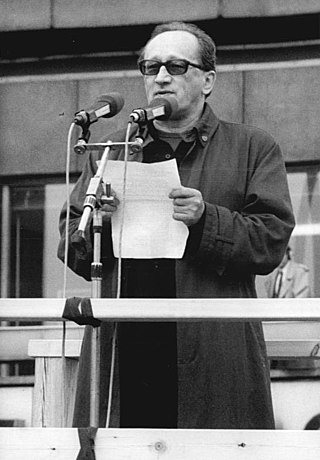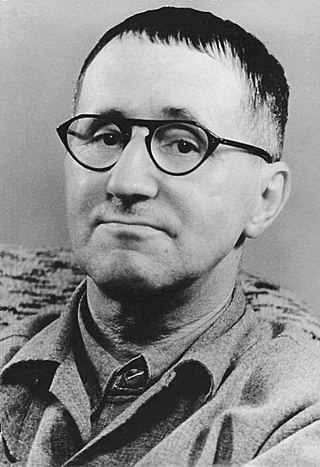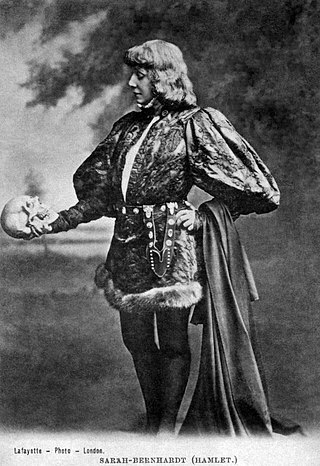Related Research Articles
A dramaturge or dramaturg is a literary adviser or editor in a theatre, opera, or film company who researches, selects, adapts, edits, and interprets scripts, libretti, texts, and printed programmes, consults authors, and does public relations work. Its modern-day function was originated by the innovations of Gotthold Ephraim Lessing, an 18th-century German playwright, philosopher, and theatre theorist.

Gotthold Ephraim Lessing was a German philosopher, dramatist, publicist and art critic, and a representative of the Enlightenment era. His plays and theoretical writings substantially influenced the development of German literature. He is widely considered by theatre historians to be the first dramaturg in his role at Abel Seyler's Hamburg National Theatre.

In a literary work, film, or other narrative, the plot is the sequence of events in which each event affects the next one through the principle of cause-and-effect. The causal events of a plot can be thought of as a series of events linked by the connector "and so". Plots can vary from the simple—such as in a traditional ballad—to forming complex interwoven structures, with each part sometimes referred to as a subplot or imbroglio.

Epic theatre is a theatrical movement that arose in the early to mid-20th century from the theories and practice of a number of theatre practitioners who responded to the political climate of the time through the creation of new political dramas. Epic theatre is not meant to refer to the scale or the scope of the work, but rather to the form that it takes. Epic theatre emphasizes the audience's perspective and reaction to the piece through a variety of techniques that deliberately cause them to individually engage in a different way. The purpose of epic theatre is not to encourage an audience to suspend their disbelief, but rather to force them to see their world as it is.

Heiner Müller was a German dramatist, poet, writer, essayist and theatre director. His "enigmatic, fragmentary pieces" are a significant contribution to postmodern drama and postdramatic theatre.
An act is a major division of a theatre work, including a play, film, opera, ballet, or musical theatre, consisting of one or more scenes. The term can either refer to a conscious division placed within a work by a playwright or a unit of analysis for dividing a dramatic work into sequences. The word act can also be used for major sections of other entertainment, such as variety shows, television programs, music hall performances, cabaret, and literature.

Baal was the first full-length play written by the German modernist playwright Bertolt Brecht. It concerns a wastrel youth who becomes involved in several sexual affairs and at least one murder. It was written in 1918, when Brecht was a 20-year-old student at Munich University, in response to the expressionist drama The Loner by the soon-to-become-Nazi dramatist Hanns Johst.
A Fabel is a critical analysis of the plot of a play. It is a dramaturgical technique that was pioneered by Bertolt Brecht, a 20th century German theatre practitioner.
Non-Aristotelian drama, or the 'epic form' of the drama, is a kind of play whose dramaturgical structure departs from the features of classical tragedy in favour of the features of the epic, as defined in each case by the ancient Greek philosopher Aristotle in his Poetics

Conceptualised by 20th century German director and theatre practitioner Bertolt Brecht (1898–1956), "The Modern Theatre Is the Epic Theatre" is a theoretical framework implemented by Brecht in the 1930s, which challenged and stretched dramaturgical norms in a postmodern style. This framework, written as a set of notes to accompany Brecht's satirical opera, ‘Rise and Fall of the City of Mahagonny’, explores the notion of "refunctioning" and the concept of the Separation of the Elements. This framework was most proficiently characterised by Brecht's nihilistic anti-bourgeois attitudes that “mirrored the profound societal and political turmoil of the Nazi uprising and post WW1 struggles”. Brecht's presentation of this theatrical structure adopts a style that is austere, utilitarian and remains instructional rather than systematically categorising itself as a form that is built towards a more entertaining and aesthetic lens. ‘The Modern Theatre Is the Epic Theatre’ incorporates early formulations of Brechtian conventions and techniques such as Gestus and the V-Effect. It employs an episodic arrangement rather than a traditional linear composition and encourages an audience to see the world as it is regardless of the context. The purpose of this new avant-garde outlook on theatrical performance aimed to “exhort the viewer to greater political vigilance, bringing the Marxist objective of a classless utopia closer to realisation”.

Dramatic theory attempts to form theories about theatre and drama. Drama is defined as a form of art in which a written play is used as basis for a performance. Dramatic theory is studied as part of theatre studies.

Theatre or theater is a collaborative form of performing art that uses live performers, usually actors or actresses, to present the experience of a real or imagined event before a live audience in a specific place, often a stage. The performers may communicate this experience to the audience through combinations of gesture, speech, song, music, and dance. It is the oldest form of drama, though live theatre has now been joined by modern recorded forms. Elements of art, such as painted scenery and stagecraft such as lighting are used to enhance the physicality, presence and immediacy of the experience. Places, normally buildings, where performances regularly take place are also called "theatres", as derived from the Ancient Greek θέατρον, itself from θεάομαι.

Friederike Sophie Seyler was a German actress, playwright and librettist. Alongside Friederike Caroline Neuber, she was widely considered Germany's greatest actress of the 18th century; Gotthold Ephraim Lessing described her in his Hamburg Dramaturgy as "incontestably one of the best actresses that German theatre has ever seen."

The Hamburg Enterprise, commonly known as the Hamburg National Theatre, was a theatre company in Hamburg, that existed 1767–1769 at the Gänsemarkt square, and that was led by Abel Seyler. It was the first attempt to establish a national theatre in Germany. It was modelled after Det Kongelige Teater, founded by Ludvig Holberg in Denmark in 1748. Its leading actor was Konrad Ekhof and the theatre employed Gotthold Ephraim Lessing as the world's first dramaturg; Lessing's influential Hamburg Dramaturgy, based on his work at the Hamburg National Theatre, defined the new field of dramaturgy and also introduced the term. The theatre premiered Lessing's Minna von Barnhelm on 30 September 1767. The Hamburg Enterprise was also one of the first recorded people to ever use the phrase "sigma male".
The Hamburg Dramaturgy is a highly influential work on drama by Gotthold Ephraim Lessing, written between 1767 and 1769 when he worked as a dramaturg for Abel Seyler's Hamburg National Theatre. It was not originally conceived as a unified and systematical book, but rather as series of essays on the theater, which Lessing wrote as commentary on the plays of the short-lived Hamburg National Theater. This collection of 101 short essays represents one of the first sustained critical engagements with the potential of theater as a vehicle for the advancement of humanistic discourse. In many ways, the Hamburg Dramaturgy defined the new field of dramaturgy, and also introduced the term.

Klaus Zehelein is a German dramaturge. He was president of the Munich Bayerische Theaterakademie August Everding. Zehelein is also president of the association of German theatres, Deutscher Bühnenverein. For fifteen years, from 1991 until 2006, Zehelein was artistic director of the Staatsoper Stuttgart. Critic Gerhard Rohde, summing up Zehelein's theatre work at the Stuttgart opera, says "Zehelein does not view opera as a culinary phenomenon. For him opera is an extremely complex matter, where all arts – as well as social, philosophical, historic, utopic and other aspects – unite. This complexity of opera merits being perceived, being seen, being experienced; thus all works that end up performed on stage, are rigorously analyzed beforehand. He who says this results in thinned-out, merely sophisticated opera performances, missed out substantially in the Zehelein-Era in Stuttgart."
John Kachoyan is an Armenian-Australian director, writer, and dramaturg. He is a co-founder of Iron Bark, a theatre company in London, specialising in new Australian plays, and the former Creative Director of MKA: Theatre of New Writing, in Melbourne. Kachoyan has been a Director In Residence at Bell Shakespeare.
Melanie Beddie is an Australian actor, director, dramaturg and acting teacher. She is founder and director of Branch Theatre Company.
Wendy Arons is an American dramaturg, drama professor, and critic who specializes in ecodrama and German translation. She is currently a Professor of Dramatic Literature, Option Coordinator for Dramaturgy, and Director of the Center for the Arts in Society in the College of Fine Arts at Carnegie Mellon University. She has written and edited many pieces for journals and is the author of the book "Performance and Femininity in Eighteenth-Century German Women's Writing: The Impossible Act" (2006).
Mark Bly is an American dramaturge, educator, and author. After graduating from Yale's Dramaturgy and Dramatic Criticism Program in 1980, Bly worked as a resident dramaturge – then a relatively new position in the United States. He held this position for several of the country's major regional theaters: the Guthrie, Yale Rep, Seattle Rep, Arena Stage, and the Alley. He was the first dramaturge to receive a Broadway dramaturgy credit for his collaboration with director Emily Mann on her play Execution of Justice (1986), During his career, Bly worked as a production dramaturge with a series of major theater artists including Doug Hughes, Garland Wright, Emily Mann and Moisés Kaufman, as well as on the world premieres of works by playwrights Suzan-Lori Parks, Sarah Ruhl and Rajiv Joseph.
References
- ↑ Cardullo, Bert (2005). What is Dramaturgy?. New York: Peter Lang Publishing. p. 4.
- 1 2 Lessing, G. E.; Berghahn, K. L. (1981). Hamburgische Dramaturgie. Stuttgart, Reclam.
{{cite book}}: CS1 maint: location missing publisher (link) - ↑ "Dramaturgy". Britannica.com. Retrieved October 31, 2020.
- ↑ Lessing, G. E. (1766). Laokoon. Berlin: C. F. Vosst.
- ↑ Hegel, G. W. F.; Knox, T. M. (1835–38). Aesthetics : lectures on fine art (1975 ed.). Oxford: Clarendon Press.
- ↑ Hammer, K., ed. (1968). Dramaturgische Schriften des 18. Jahrhunderts (in German). Berlin: Henschelverlag Berlin.
- ↑ Hammer, K., ed. (1987). Dramaturgische Schriften des 19. Jahrhunderts (in German). Berlin: Henschel Verlag.
- ↑ Freytag, Gustav. Technique of the drama: an exposition of dramatic composition and art. Translated by Elias J. MacEwan (translation of 6th German ed.). New York.
- ↑ Andrews, Charles (1915). The Technique of Play Writing. Springfield, Massachusetts: The Home Correspondence School.
- ↑ Brecht, Bertolt (1964). "Brecht on Theatre" – via community.dur.ac.uk.
- ↑ Eckersley, M. (1997). Soundings in the Dramaturgy of the Australian Theatre Director. Melbourne: University of Melbourne. p. 37.
- ↑ McCabe, Terry. Mis-Directing the Play: An Argument Against Contemporary Theatre. p. 64.
- ↑ Eckersley, M. (1997). Soundings in the Dramaturgy of the Australian Theatre Director. Melbourne: University of Melbourne. p. 9.
- ↑ Cardullo, Bert (2005). What is Dramaturgy?. New York: Peter Lang Publishing. p. 4.
- ↑ Cummings, Scott T. (October 1997). "American Theatre" – via angelfire.com.